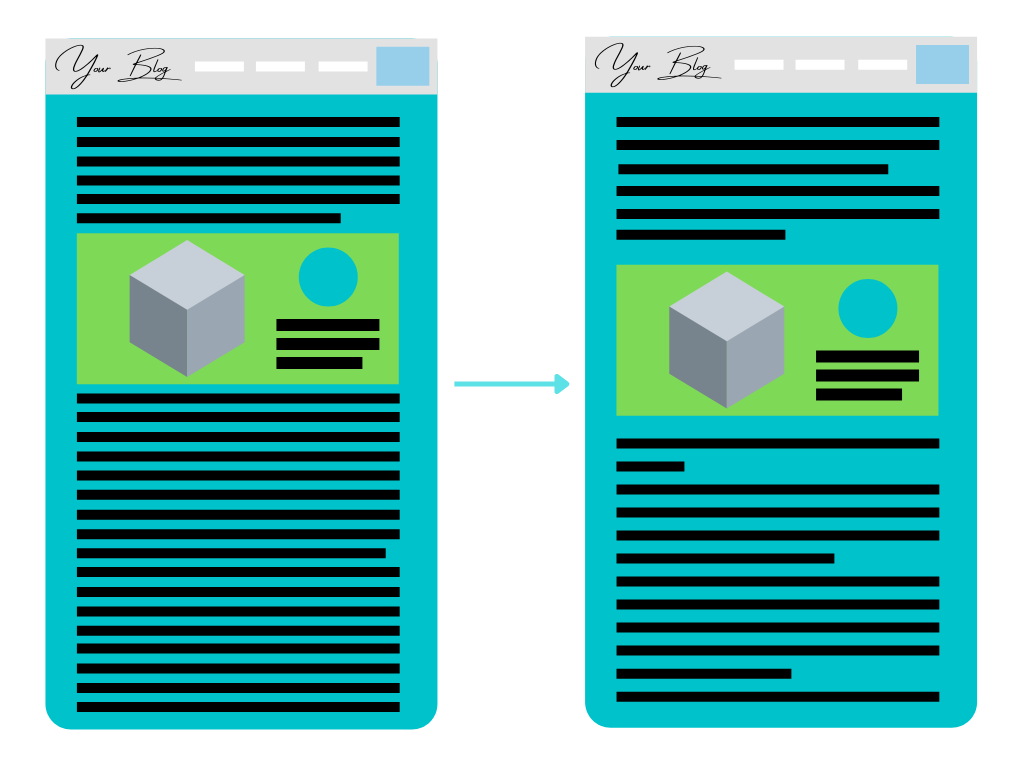Numbers Talk: How Websites Can Be Successful
Every month, 409 million people visit over 20 billion blog pages, and businesses that blog get 55% more website visitors than businesses that don’t; more website visitors means more potential consumers, which means more transactions between clients and your business. With statistics like these, readers and marketers alike can’t deny the importance of blog posts for reaching audiences in today’s era of widespread internet access and ecommerce. Blogs have remained a popular tool for content marketers of all sectors to share their insights, knowledge, and expertise with readers around the world, and are the most effective channel for businesses to foster organic brand loyalty and trust within readers and consumers.
However, blog owners will find themselves wondering how to maximize their blog’s potential to attract as much traffic and engagement as possible. To answer this key question, we’ll need to consider several factors of your blog and its content, from the amount of content presented in each blog post to the frequency with which you add to your overall catalog of posts.
Having operated and analyzed blogs for years as a marketing and communications analyst, I’ve gained some valuable insight into how a blog should be operated and what considerations should be made in order to maximize any blog’s reader traffic and engagement.
How long should your blog posts be?
Content Ranges
Content Length’s Role
From a perspective that considers SEO, search engines like Google might observe that readers aren’t spending much time on your shorter blog posts when compared to competitors’ blogs that feature longer content, and thus factor this into ranking your content lower in its search results. A purpose of blogs is to retain readers for long enough with quality content so that their engagement is sustained and consistent, after all, with longer content tending to fulfill this goal much more than shorter blog posts.
Key advice for a blog post’s length is to write as much as necessary to completely cover the topic you’re discussing, and, when you’re unsure about how much you should write, to lean towards writing longer content rather than writing shorter pieces.
What should your blog post layouts be like?
Layout Theory
When readers explore your content, you want them to feel comfortable and at ease so that your content is something they want to continue consuming and, in the future, consider returning to. This is why content layouts and the impressions they make on your readers contribute a large amount to what readers will think of your blog’s appeal and content.
Layout Considerations
On the other hand, content that is densely packed together, with less spacing between sentences, paragraphs, and images, creates a cramped presentation that might feel overwhelming and unpleasant for readers, resulting in them leaving your blog to consume content elsewhere with a more pleasing layout of its content. An easy solution to cramped layouts is increasing the spacing between individual lines of text, paragraphs, and images. Remaining mindful of long paragraphs and splitting them into separated sentences also alleviates cramped reading experiences for your audience.
When writing and designing your blog posts, remember to take your readers’ experiences and preferences into consideration to maximize the appeal that your posts and content have.
The diagram above demonstrates the difference between a website with no white space in its layout and a site with more spacing between its lines and more overall white space in its layout. The site on the right side is more desirable, as it feels much less crowded or cramped than the left side, and gives visitors a more comfortable reading experience.
How often should you post on your blog?
Frequency
To make yourself stand out from your competition, the frequency and consistency with which you post on your blog is a proven way to retain your traffic and maximize your blog’s success.
Different statistics offer somewhat varying insights into exactly how frequently blogs should post to maximize reader engagement, but generally, 11-16 blog posts a month is the ideal amount to aim for, with 11 posts a month in particular being found to double traffic in practically all scenarios in one study. These statistics should be considered together with the size of your operations, as businesses of different sizes will have different reader engagement goals in mind when maintaining their blog, which will factor into determining the frequency of your blog posts.
Smaller or more specialized businesses should post around 1-3 times weekly to give their blog, and by extension their business, visibility and prove their expertise in relevant topics. Larger blogs for bigger businesses that are already catering to a decent amount of organic traffic should post 4-5 times weekly to maintain your audience base, continue growing your company’s brand, and establish yourself as a reputable and quality source that readers can trust and turn to.
– Andy Crestodina, CMO of Orbit Media
Consistency
Readers appreciate sources of knowledge that are updated frequently and predictably, which lends itself to cultivating frequent readers who come to recognize your content and even become loyal supporters of anything you release. Blog traffic compounds and gains organic results over time, so long-term loyalty of organic readers is vital to your blog earning organic traffic.
Search engines similarly appreciate content that engages and retains its readers for longer periods of time. Longer time spent on blog posts demonstrates quality of content to the search engine that it will rank higher in search results. When your blog ranks higher in search results, visitors are much more likely to click onto your website out of curiosity, or because they trust the search engine’s rankings of good content.
Also, regardless of whether someone visits your site, simply seeing your blog’s name ranked higher in search results contributes to growth in brand awareness, which is always desirable for attracting potential clients.
How many posts should your blog have?
Numbers Game
Expanding your Content Library
Reaching between 55 to 70 consistently posted blogs has been found to be a milestone that triggers search engines to deem a blog’s content as legitimate, resulting in a permanently increased amount of website traffic and improved rankings. As you add to your catalog of blog posts, you should see a gradual organic increase in the engagement that each of them receive, which will compound as you add more posts and result in your blog’s traffic increasing greatly over an extended period of time.
Having built up a large catalog of blog posts that date back in time and show consistent maintenance demonstrate to readers that your blog is established and legitimate, has been active for an extended period of time, and possesses a deep range of expertise and knowledge.
In the image above, individual buttons have been grouped together to form a large pile of buttons. Your blog posts are similar, in that one blog post may not feel significant, but building up a large catalog of posts over time will make a large impact and demonstrate the authority of your blog, which readers and search engines alike will pick up on.
Should you focus more on quantity or quality?
Quantity Over Quality
First and foremost, quantity draws better results than quality due to the innate nature of blogs being used to reach consumers. Many blog posts of good quality will draw more traffic and engagement than only a few blog posts of extremely high quality, simply due to consumers having more opportunities to encounter your content and be drawn in by it, and your credit with search engines increasing as a result.
Whether blogs are successful in drawing desired traffic is in large parts a numbers game, so maybe the time you’ve spent drafting and planning that long meticulous article with 50 sources for the past month could be better prioritized on producing articles that take less overall time and aren’t as demanding during their creation process. Your energy can instead be spent on creating more opportunities for readers to find you and search engines to recognize your work.
This isn’t to say that there are no quality standards for blog posts, as readers do have baseline expectations for your content’s quality, but every blog post doesn’t necessarily have to be a masterpiece (although it still could be!): as long as readers and search engines can appreciate your posts for what they have to offer, your blog will already be succeeding.
The image above shows cargo being processed and moved at a shipping dock. Just as this dock processes cargo, building up your blog’s catalog of posts may seem like a daunting task at first, but when you keep in mind that you have wiggle room in how you operate your blog, your blog posts don’t have to be perfection, and real progress is being achieved, you’ll find the process becoming easier and more manageable over time.
Finding Inspiration
Some blog writers and operators may be concerned about whether they can continuously produce fresh topics and discussions as blog content, but there’s less difficulty here than some might think.
Inspiration for posts can be found practically anywhere, from discussing with your partners and employees, to reading articles, studies, and other blogs online. Simply thinking about recent trends, observations, or changes in your industry or sector can become a great springboard for brainstorming and creating unique and engaging blog content. Anything you find interesting and relevant to your background, business, or audience can be turned into an insightful blog post that genuinely intrigues readers and wins your blog organic traffic and search engine recognition.
Looking to maximize the traffic to your blog based on popular online searches? Helpful tools like Google Trends, Answer the Public, and Keyword Tool are all great services that let you see what search terms are popular within different locations, demographics, online platforms, and more. With this information in hand, you’ll be able to come up with different topics to write about, as well as plan on appealing to different audiences based on your knowledge of where and what kinds of content different people consume. Inspiration will come easier to you once you’re aware of what topics and ideas catch people’s attention.
Additionally, once you’ve built up a larger catalog of blog posts, you can always refresh and/or rewrite your older content, which injects new life and interest into content that had already been created and published in the past. The best part is, when you’re personally interested or knowledgeable in the topics you’re writing about, the writing part comes more naturally to you since you’re discussing something you already have interest or knowledge in, which should streamline your process and make it easy for you to create your desired amount of quality content.
Potential blog visitors will always have a curiosity for new discussions on content, so as long as you’re producing an amount of content that will interest audiences, your blog’s organic growth will eventually be unavoidable.
What should you consider when committing to a blog?
Long-Term Investment
From the outset of your blog, you’ll be wanting to prioritize frequent and consistent updates, which could become a large amount of time spent on a weekly or monthly basis that might put people off from the idea of writing for and maintaining a blog.
Individual Limitations
The issue of manpower availability can be minimized if your blog is run by or affiliated with a larger company that has people on hand to produce blog content, but if your blog is a smaller operation, you might find difficulty in ensuring it stays maintained and frequently updated.
If you find yourself struggling with this issue, it’s perfectly acceptable to cut down on the amount of content you aim to post, but under this scenario, it’s hard to say whether your blog will attract as much traffic and give you the degree of success you aim for with your content. It’ll be up to your own circumstances to weigh how much time and investment you want to put into creating blog content.
Final Thoughts
Having learned about creating a successful blog, you should feel more confident about how to run a blog. Regardless of your experience level, blogs are very easy to start and more manageable than you’d think! If you’re newer to creating blogs and are looking to get a running start with great benefits, consider signing up with website.com. They offer a website builder with easy-to-use features that serves as a great starting point for anyone who wants to run blogs.
If you’re more experienced with creating blogs, why not try creating a site with WordPress, and then hosting your site with a value-packed hosting service like Doteasy? I recently noticed that they’re offering a set of hosting plan deals in which you can get a free domain name registered alongside getting your site hosted with them, which sounds to me like a great starting point for any aspiring website owner. Particularly with their WordPress hosting options, you get a ton of value thanks to the plan’s included domain name, free domain renewal on specific options, knowledgeable and responsive in-house support, and more. I myself have had a great experience with them so far after switching from Bluehost, so I’d recommend you give them a try too.
Regardless of how you go about creating your blog, any blog can find success as a well-crafted source of information and advice. Think about what’s been discussed in this article, and apply it to your own website and business. With discipline and effective execution, your blog can reach new heights and take your online presence further than it’s ever been.



